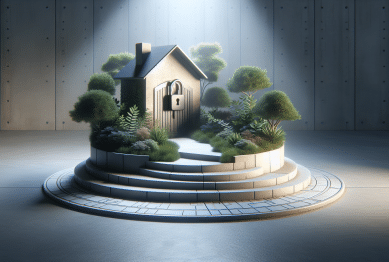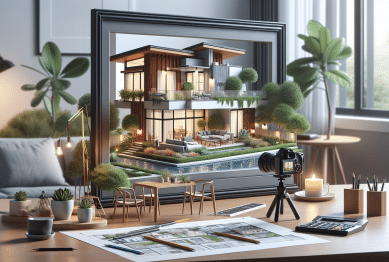Expanding interest in eco-friendly homes is shaping real estate trends. This guide showcases how sustainable housing can impact comfort, costs, and resale value. Explore how building materials, smart upgrades, and energy efficiency influence daily life and long-term investment.
Understanding the Appeal of Sustainable Housing
Sustainable housing isn’t just a passing trend—it’s an inspiring shift in how individuals approach both homeownership and daily living. When people search for real estate, they’re increasingly drawn to properties that uphold green building standards and healthier living environments. Features such as solar panels, advanced insulation, and rainwater harvesting systems are boosting property appeal. Potential residents often discover that energy-efficient homes lead to lower utility bills and a smaller carbon footprint over time. As information about eco-friendly living continues to spread, buyers ask about long-term maintenance, cost savings, and technologies available in their next potential residence.
Energy-efficient homes do more than reduce bills. They create comfortable environments year-round. Superior insulation helps keep interiors cool in summer and warm in winter, minimizing reliance on mechanical systems. Innovations in smart thermostats and LED lighting also optimize resource consumption without requiring constant oversight. A sustainable building often utilizes recycled and locally sourced materials, minimizing its environmental impact from the very beginning. Buyers find these measures reassuring—they’re investing in a healthier, lower-maintenance future that aligns with broader environmental values.
Many first-time homebuyers are curious about sustainable upgrades available in existing homes as well as new developments. Real estate agents and industry groups encourage prospective purchasers to consider resale value, local incentives, and potential tax credits associated with energy-efficient improvements. The presence of green certifications can nudge decisions, laying the groundwork for financial and ecological gains. As consumers become more savvy about home energy ratings and material sourcing, the importance of sustainability within the housing market only continues to grow.
Key Elements of Eco-Friendly Home Construction
Sustainable homes prioritize eco-conscious building materials such as bamboo flooring, recycled steel, and reclaimed wood. These alternatives often outperform traditional materials in durability and require less energy to produce. Thoughtful design includes well-placed windows for natural lighting, and orientation for passive solar heating or cooling. Low-VOC paints and non-toxic insulation foster improved indoor air quality, appealing to families concerned about health. Homebuilders are now adopting comprehensive strategies that marry energy conservation, comfortable living, and innovative aesthetics. The increasing availability of these materials is making green construction not only possible but preferable for many buyers and investors.
Water conservation is another hallmark of sustainable home design. Installing dual-flush toilets, efficient showerheads, and systems for capturing rainwater helps maintain resource abundance. Landscape plans frequently feature native or drought-tolerant plants that minimize the need for irrigation, lowering ongoing utility costs. Green roofs and permeable pavements further manage stormwater runoff, reducing a home’s environmental footprint and contributing to resilient urban infrastructure. These features aren’t just beneficial to the environment—they enhance a property’s performance and comfort.
Smart home technology now plays a pivotal role in managing energy and water use. Devices such as automated lighting, occupancy sensors, and energy monitoring hubs give residents control and insight. By tracking patterns in water or electricity usage, homeowners adjust behaviors or settings for better efficiency. Many local governments are encouraging the installation of such technologies by offering rebates, accelerating adoption throughout neighborhoods. The integrated approach of smart technology and green building materials defines the next wave of eco-friendly housing—and it’s easier to access than ever.
Benefits of Investing in Sustainable Properties
Choosing a sustainable property brings both immediate and long-term rewards. Utility savings can be noticed within the first few months—energy-efficient appliances, solar panels, and improved insulation all work to minimize power consumption. This reduction often translates into hundreds or even thousands saved annually compared to conventional homes. These savings can help offset the initial investment in green upgrades, making sustainable housing appealing not just for ethical reasons but for practical budget considerations as well. Additionally, properties with high energy efficiency ratings tend to have increased resilience to energy price fluctuations, providing peace of mind to homeowners and investors.
Another compelling reason to consider green real estate is the boost it can give to resale value. Market studies show eco-friendly homes can fetch higher prices and sell faster (Source: https://www.nar.realtor/research-and-statistics). Modern buyers are willing to pay more for features such as solar arrays and efficient HVAC systems. Certifications like LEED or ENERGY STAR make a property stand out in crowded markets. As regulations shift toward stricter energy codes and carbon targets, already-upgraded homes will maintain their competitive edge. Sustainable features have begun to move from ‘nice-to-have’ to ‘must-have’ in many regions.
Owners of eco-friendly properties often enjoy a healthier living environment, which is especially attractive for families with children or individuals with allergies. Improved ventilation, natural lighting, and non-toxic materials are more than comfort upgrades—they contribute to overall wellness. Over time, reduced exposure to harmful chemicals and improved air quality can support long-term health and comfort. Collectively, cost savings, health benefits, and increased market value create a compelling case for investing in sustainable homes that serve both personal and broader societal goals.
Financing and Incentives for Green Homes
Financing a sustainable home is becoming easier as mortgage products and financial incentives expand. Lenders increasingly recognize the value of green features, offering loan products that factor in energy efficiency. Green mortgages and energy-efficient improvement loans may allow buyers to borrow additional funds for upgrades such as solar panels, high-efficiency HVAC systems, or windows (Source: https://www.energystar.gov/about/federal-tax-credits). These specialized mortgages consider lower anticipated utility costs when determining the borrower’s creditworthiness, making eco-friendly investments more accessible.
Government incentives—like rebates, tax credits, and grants—encourage the installation of renewable energy systems, efficient appliances, and insulation. Programs may be offered at the local, state, or federal level. For many homeowners, these can significantly reduce the upfront costs associated with green building or retrofits. Real estate professionals and financial advisors can help navigate the array of available options for maximizing savings (Source: https://www.energy.gov/eere/buildings/federal-energy-management-program). The result is a broadening path to accessible, affordable sustainable housing.
Energy performance contracts and property assessed clean energy (PACE) programs further extend choices. With these, costs for major improvements can be paid over time through special assessments on property taxes. Buyers are advised to weigh the terms and conditions associated with these options, as well as the long-term financial implications. Ultimately, a growing portfolio of financing mechanisms ensures that more individuals and families can access—and benefit from—the latest advances in green living, regardless of their initial budget.
Navigating the Search for a Sustainable Home
As interest grows, buyers are prioritizing sustainability during their home searches. Online real estate platforms now feature filters for energy efficiency, green certifications, and renewable energy installations. Prospective residents analyze listings for features such as solar panels, geothermal heat pumps, and water-conserving fixtures. Researching local building codes and neighborhood sustainability initiatives can reveal added value that extends beyond a single property. Comparing regional programs and average costs encountered during the search process is becoming standard practice for those concerned with sustainability.
Insightful buyers conduct home energy audits before purchase when possible. These audits help identify opportunities for retrofitting newer appliances, advanced insulation, or improved ventilation. Some sellers offer disclosure documents that outline a property’s green upgrades and energy performance history, providing buyers with confidence. Real estate professionals specializing in eco-friendly homes are a valuable resource, adept at highlighting features, interpreting certifications, and clarifying regional incentives. A focused search supported by practical research streamlines the process and empowers informed decisions.
Community aspects shouldn’t be overlooked. Sustainable neighborhoods often include amenities such as shared gardens, efficient transportation options, and collaborative waste management initiatives. Connecting with local groups can provide additional insights into how sustainability influences day-to-day living and community engagement. In this way, the search for a sustainable home often becomes a pathway to a more integrated, responsible, and socially rewarding lifestyle.
Smart Upgrades and Future Trends in Green Living
Homeowners committed to sustainability continue to upgrade their properties with emerging technologies. Solar roof tiles, battery storage systems, and advanced water filtration systems are among the most popular current upgrades. These innovations aim to reduce dependence on external resources and increase self-sufficiency. As energy storage becomes more affordable, many anticipate a future where homes double as micro-power plants—while also supporting electric vehicle charging and neighborhood power sharing. The pace and variety of new advancements make ongoing research an essential step for anyone interested in sustainable living.
The next chapter in real estate also involves full-home automation: integrated devices that balance comfort, security, and resource efficiency. For example, predictive analytics in smart thermostats and appliances can adjust schedules based on occupancy or utility rates. Home design is evolving, too. Movements like tiny homes and modular construction offer resource-efficient environments that maximize space and minimize waste. These trends not only appeal to individuals seeking lower ecological footprints but also to investors interested in future-proof properties.
Wider adoption of sustainability standards is changing how communities are designed. Regulatory shifts are encouraging developers to exceed minimum energy codes, with an emphasis on decarbonization and biodiversity preservation. As both urban and rural areas adopt green building practices, demand for sustainable real estate continues to increase. Those curious about ongoing developments are encouraged to follow local initiatives, review growth reports, and explore opportunities for continual home improvement. The movement toward sustainable housing shows no signs of slowing down.
References
1. U.S. Department of Energy. (n.d.). Energy Saver: Sustainable Building Materials. Retrieved from https://www.energy.gov/energysaver/design/sustainable-building-materials
2. National Association of Realtors. (n.d.). Sustainability Program: Home Features. Retrieved from https://www.nar.realtor/research-and-statistics
3. ENERGY STAR. (n.d.). Federal Tax Credits for Consumer Energy Efficiency. Retrieved from https://www.energystar.gov/about/federal-tax-credits
4. U.S. Department of Energy. (n.d.). Federal Energy Management Program. Retrieved from https://www.energy.gov/eere/buildings/federal-energy-management-program
5. U.S. Environmental Protection Agency. (n.d.). Indoor Air Quality (IAQ). Retrieved from https://www.epa.gov/indoor-air-quality-iaq
6. U.S. Green Building Council. (n.d.). LEED Rating System. Retrieved from https://www.usgbc.org/leed









